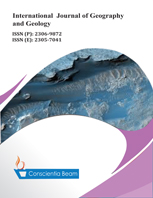Climate Change Vulnerability in Rwanda, East Africa
DOI:
https://doi.org/10.18488/journal.10.2019.81.1.9Abstract
This study aims to spatially assess the flood vulnerability then suggests appropriate vulnerability lessening and adaptation mechanisms in Rwanda. Six vulnerability factors namely the rainfall and temperature, total population, access to communication tools, poverty level and number of schools were analyzed. The Weighting Linear Combination (WLC) method in ArcGIS is used to analyze these factors and spread the resulting flood vulnerability countrywide. The results showed high flood vulnerability within the northern, western and southern provinces and Kigali city of Rwanda. This vulnerability is likely to rise due to the noticed low possession of communication tools and education delivery, which could help to enhance the risk awareness and preparedness among the vulnerable communities. The results of this study can help policy makers to understand the required community’s vulnerability lessening measures and ensure spread of mitigation and adaptation policies as per vulnerability extent within Rwanda.

